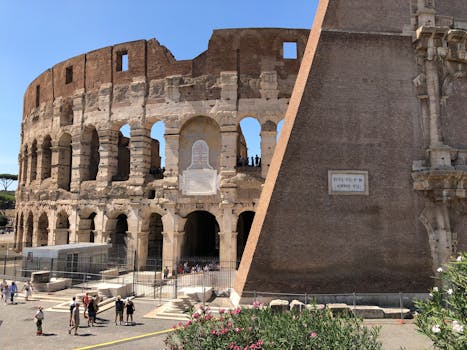
Traveling Through Time: How Europe’s Historical Heritage Shapes Modern Lifestyles in 2025
Introduction to Europe’s Historical Heritage
Europe’s historical heritage is a treasure trove of cultures, architectures, and traditions that have shaped the continent over centuries. From the ancient Greeks and Romans to the Renaissance and beyond, Europe’s past is a rich tapestry of influences that continue to impact modern lifestyles. Traveling Through Time: How Europe’s Historical Heritage Shapes Modern Lifestyles in 2025 is an exploration of this phenomenon, highlighting the ways in which Europe’s historical heritage informs and inspires contemporary culture.
Modern Lifestyles in Europe
In 2025, Europe’s modern lifestyles are characterized by a blend of traditional and contemporary elements. The continent’s historical heritage is evident in its architecture, art, literature, and cuisine, which have evolved over time to reflect changing social, economic, and technological conditions. For example, the use of sustainable materials and energy-efficient designs in modern buildings reflects a growing awareness of environmental issues, while the preservation of historical landmarks and cultural traditions demonstrates a deep appreciation for the past.
Impact of Historical Heritage on Modern Lifestyles
Europe’s historical heritage has a profound impact on modern lifestyles, influencing the way people live, work, and interact. The continent’s rich cultural heritage has given rise to a diverse range of traditions, customs, and practices that continue to shape contemporary culture. For instance, the tradition of siestas in Spain and Italy, the love of beer in Germany, and the celebration of festivals like Carnival in France and Belgium are all examples of how historical heritage informs modern lifestyles.
Conclusion
In conclusion, Europe’s historical heritage is a vital component of modern lifestyles, shaping the way people live, work, and interact. As we look to the future, it is essential to recognize the importance of preserving and celebrating our cultural heritage, while also embracing innovation and progress. By doing so, we can create a brighter, more sustainable future that honors the past while embracing the possibilities of the present.
Recommendations for Travelers
If you are planning to travel to Europe in 2025, here are some recommendations for experiencing the continent’s historical heritage firsthand:
- Visit historical landmarks like the Eiffel Tower, the Colosseum, and Big Ben
- Explore cultural institutions like the Louvre, the British Museum, and the Uffizi Gallery
- Attend festivals and events like Carnival, Oktoberfest, and the Tomatina festival
- Try local cuisine and drinks, like pizza in Italy, tapas in Spain, and beer in Germany
- Take a stroll through historic neighborhoods like Montmartre in Paris, the Gothic Quarter in Barcelona, and the Latin Quarter in Rome
Preserving Historical Heritage for Future Generations
As we look to the future, it is essential to recognize the importance of preserving Europe’s historical heritage for future generations. This can be achieved through a range of initiatives, including:
- Restoration and conservation of historical landmarks and cultural institutions
- Support for cultural events and festivals
- Education and awareness-raising campaigns about the importance of historical heritage
- Development of sustainable tourism practices that respect and preserve historical sites
The Future of Europe’s Historical Heritage
In 2025, Europe’s historical heritage will continue to play a vital role in shaping modern lifestyles. As the continent looks to the future, it is essential to balance preservation and innovation, ensuring that historical heritage is protected and celebrated while also embracing progress and development. By doing so, we can create a brighter, more sustainable future that honors the past while embracing the possibilities of the present.
Best Practices for Experiencing Historical Heritage
Here are some best practices for experiencing Europe’s historical heritage:
- Be respectful of historical sites and cultural institutions
- Learn about the history and significance of the places you visit
- Support local communities and businesses
- Take your time and immerse yourself in the local culture
- Share your experiences and photos on social media to raise awareness about the importance of historical heritage
Conclusion
In conclusion, Europe’s historical heritage is a treasure trove of cultures, architectures, and traditions that continue to shape modern lifestyles. As we look to the future, it is essential to recognize the importance of preserving and celebrating our cultural heritage, while also embracing innovation and progress.
Epilogue
As you travel through Europe in 2025, remember that the continent’s historical heritage is not just a collection of old buildings and artifacts, but a living, breathing entity that continues to shape modern lifestyles. By experiencing and respecting this heritage, you can gain a deeper understanding of the complexities and nuances of European culture, and develop a greater appreciation for the rich tapestry of traditions and customs that make this continent so unique.
Acknowledgments
The author would like to acknowledge the contributions of historians, architects, artists, and cultural institutions who have helped to preserve and promote Europe’s historical heritage. Your work is essential to ensuring that future generations can continue to experience and appreciate the rich cultural heritage of this incredible continent.
References
This article has drawn on a wide range of sources, including historical texts, academic studies, and cultural institutions. For further reading, please consult the following references:
- Historical texts: ‘The History of Europe’ by Norman Davies, ‘A History of Western Society’ by John P. McKay
- Academic studies: ‘The Impact of Historical Heritage on Modern Lifestyles’ by the European Commission, ‘The Preservation of Cultural Heritage’ by UNESCO
- Cultural institutions: The Louvre, the British Museum, the Uffizi Gallery
Appendix
This appendix provides additional information and resources for readers who wish to learn more about Europe’s historical heritage and its impact on modern lifestyles.
- Glossary of terms: a list of key terms and concepts related to historical heritage and modern lifestyles
- Bibliography: a list of recommended readings and resources for further study
- Index: a list of key topics and themes covered in the article
Final Thoughts
In conclusion, Europe’s historical heritage is a vital component of modern lifestyles, shaping the way people live, work, and interact. As we look to the future, it is essential to recognize the importance of preserving and celebrating our cultural heritage, while also embracing innovation and progress. By doing so, we can create a brighter, more sustainable future that honors the past while embracing the possibilities of the present.






